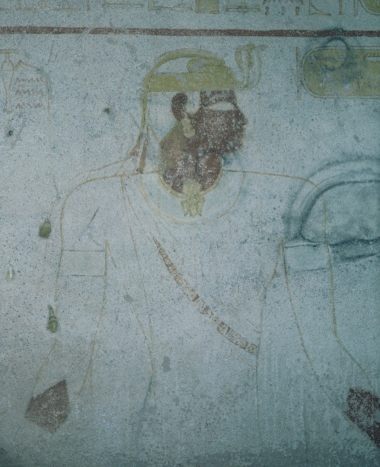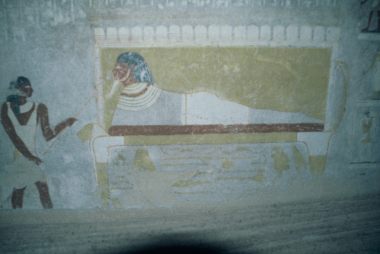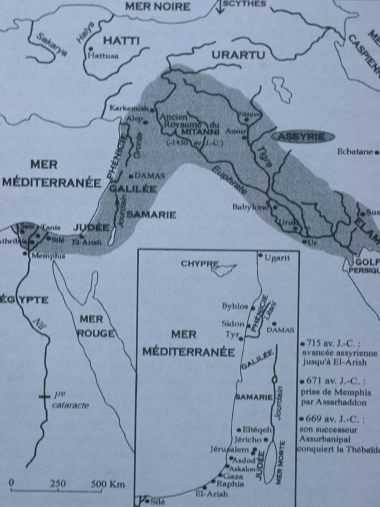


|
THE XXV DYNASTY: a return to the sources The disappearance of the Ramessides allowed Nubia to return to independence. Under the Egyptian XXII Dynasty, the border is fixed at Aswan, as in the time of Djoser.
The retreat of the Northerners favours, between the X and VIII Centuries BC, the emergence of chiefdoms and principalities. The populations return to their old ways of life and some burials testify to the use of ancient funerary rites. The Egyptian towns are deserted and the temples abandoned. The local chiefs most likely take over from the old governors and the Egyptians that had remained in the temples mix with the local population. Since the IX Century BC, a group native to Jebel Barkal begins an important period with two phases: the Kushite period, from which the XXV Egyptian dynasty originates (c. 900-650 BC), and the kingdom of Napata (c. 650-270 BC). The kingdom of Meroe (c. 270 BC to AD 250) takes over and prolongs its life up to the VI Century of our era, including a post-Meroitic period. NAPATA, CAPITAL AND HOLY CITY At the cross-roads of the caravan routes, this agglomeration located at the level of the Fourth Cataract existed during the Kerma period. It was dominated by the 'pure and holy' mountain, a tabular plateau that stands 90m high. However, the fortress the Egyptian texts speak of, was probably located on the East bank of the cataract. On the other hand, the town created by the Egyptians during the New Kingdom, an arrival point of the caravans from the south, was located according to some scholars on the West bank, near Sanam. EMERGENCE OF THE XXV DYNASTY During the VIII Century BC, some Napatan chiefs, ethnically, linguistically and culturally different from the Egyptians, took control of the North. |
    Taharqa's temple at Kawa / Temple de Taharqa à Kawa
Tanouetamani king painted on one wall of his grave at El-Kurru / Représentation du roi Tanouétamani sur une des parois de sa tombe à El-Kurru
Qalhata Queen on her funeral bed during the ritual of "the mouth opening" (the oup-ro). Grave at El-Kurru / La reine Qalhata sur son lit funéraire durant le rituel "de l'ouverture de la bouche" (l'oup-ro). Tombe à El-Kurru
Assyrian domination on Middle East country (IXth - VIIth century before Christ) / Domination assyrienne (IXè-VIIè s avant Jésus-Christ) sur le Moyen-Orient
|
|
The sixth or seventh member of this Napatan dynasty appears under the name of Alara (785-760 BC). He placed his faith in Amon and was declared king. He adopted the Egyptian regal characteristics, such as the inscription of his name in a cartouche. After three centuries of independence, the Nubians of the Fourth Cataract are still little influenced by the civilisation of the North. Alara dominates Upper Nubia as far as Kawa where he builds a sanctuary to the god Amon, as well as at Jebel Barkal. He is the founder of a dynasty that will become, under Shabaqo, the Egyptian XXV Dynasty. His brother Kashta, the 'Kushite' (760-747 BC) succeeds him and extends his kingdom as far as Lower Nubia. To learn more, click here (annexe 2)
His successor, Piye, ascends the throne (747-716 BC) and takes the coronation name of Thutmose III, Menkheperre, 'the manifestation of Re (the sun) is closed'. In the third year of his reign, Piye has a stelae carved confirming that he is king of Egypt and of 'all the countries'. The sovereign tolerates in Lower Egypt the presence of the other kings, but always through Amon of Napata, the sovereignty of Piye is superior to that of the others. He imposes himself against the dissident princes of the Egyptian delta. To learn more, click here (annexe 3) At the end of the reign of Piye, Assyria is a power to be reckoned with. The Assyrians have reached the Wadi el-Arish. They are only separated from the Egyptian border by the town of Sile, the eastern approach to the delta.
In view of the gravity of the situation, Shabaqo, the successor to Piye, installs himself at Memphis to better control the dynasts of the North and to block possible invasions. He shows both wisdom and political nous, in refusing to accept any of the alliances that are offered to him. He sends back manu militari the king Asdod, who had tried to seek refuge in Egypt. Shabaqo dies in 702 BC after a reign of 15 years. Shabatqa (702-690 BC), son of Piye, takes over. At the time of the accession to the throne of the Assyrian king Sennacherib, Phoenicia and Palestine revolt. The king of Judea asked for help from an Egyptian contingent. It is very likely that it was the dynasts of the delta that responded to this appeal, such as Orsorkon IV, the famous So of Egypt, an obscure descendant of the XXII Dynasty that had responded to Sargon under Shabaqo. The help brought to the king of Judea pushed Sennacherib to turn against the Egyptians. Shabatqa entrusts his army to his brother Taharqo but battle does not take place, the Assyrian camp is ravaged by an epidemic, ensuring that status quo ensues between the two powers. Shabatqa dies in 690 BC and Taharqo succeeds him (690-664 BC) Taharqo will govern for twenty-six years a territory that extends from the delta to the confluence of the two Niles. His reign is divided into two periods: the first is very prosperous, the second, from 677 to 664 BC, is marked by a confrontation with the Assyrian Empire, with dramatic consequences for the 'black pharaohs'. Between 690 and 677 BC, Egypt returns to being the power it had once been. Art finds new vigour and Taharqo orders the construction across his domains of the most beautiful monuments of his dynasty. Considering his military success against the Libyans and the Egyptian influence over the Phoenician ports, it is difficult to understand the reasons for the fall of Taharqo. It seems that the uprising of the Phoenician cities pushed Assarhaddon to attack Egypt. In 671 BC, Memphis was taken. Taharqo reconquers it, most likely with the intention of confronting Assurbanipal, the successor of Assarhaddon. The Assyrian king engaged Syrian, Phoenician mercenaries as well as contingents drafted from the delta. In 669 BC, they descended into Upper Egypt and took Thebes. To learn more, click here (annexe 4) Nekao I, decreed king of Egypt by the Assyrians, must face the successor of Taharqo, Tanwetamani, the son of Shabaqo. The 'Black Pharaoh' took Memphis and fights Nekau, who is killed. The delta dynasts submit to Tanwetamani but then turn around and once more ask for the help of the Assyrians. The latter return to Egypt, destroy Thebes and place on the throne the son of Nekao I, Psammetic I, thus inaugurating the XXVI Dynasty.
From the reign of Psammetic I onwards, the political independence of Egypt, which had prevailed during millennia, begins to decline. The country opens up to the Mediterranean world and enters 'modern times' with the creation of Alexandria, which marks the apogee of the Hellenistic period. For the Greek intellectuals that were beginning to visit Egypt, according to Timothy Kendall, Nubia will no longer be 'but the legend of a far-away Ethiopia (*), of a population of men without task that had engendered the culture of Egypt. According to the Homeric formula, Osiris was one of the Ethiopians with perfect hecatombs that had colonised Egypt, Ethiopia remaining the elected land of the gods'. (*) The Ethiopia of the Greeks was Nubia, the land of the cataracts.
See on the slide show, the map of "domination of the second Assyrian Empire (IX-VII Century BC) over the Near and Middle East
On this subject, read the book by Joy Soulé-Nan 'La Nubie des Pyramides'
|
|